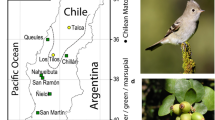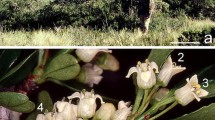Abstract
The diversity of fruit types within the Amentiferae appears to be the result of different seed dispersal and seedling establishment strategies that have evolved independently in the amentiferous families within the confines imposed by the wind-pollination syndrome. Dispersal of unadorned fruits and seeds by wind (e.g.,Betula, Rhoiptelea, Casuarina) has preceded the development of more efficient air-borne devices (e.g.,Ostrya, Carpinus, Engelhardia). Animal dispersal is the most advanced strategy, relying rarely on drupes, as in the shrubby Myricaceae, or on nuts, as inCorylus, Quercus, Carya, Juglans, Alfaroa, etc. The pattern of seedling establishment shows a structural-functional relationship to the seeddispersal strategy. Epigeal germination predominates in plants of open habitats. Those species with small fruits rely on wind dispersal, and their seeds have a relatively short germination time, whereas species with medium-sized fruits are often animal-dispersed with seeds that may have protracted germination times. In either case the reserve food supply for the young seedling is limited, and light is needed to spark photosynthesis. Hypogeal germination has evolved independently in several amentiferous families (e.g., Betulaceae, Fagaceae, Juglandaceae). This pattern is associated with closed habitats and plants with large seeds that have the capability of establishing vigorous seedlings in microhabitats of reduced light intensity where photosynthesis is impaired. The subterranean protection afforded the cotyledons and axillary meristems is a correlative feature that may have considerable importance in seedling survival where desiccation and predation are intense.
Similar content being viewed by others
Literature Cited
Abbe, E. C. 1935. Studies in the phylogeny of the Betulaceae. I. Floral and inflorescence anatomy and morphology. Bot. Gaz. (Crawfordsville)97: 1–67.
—& T. T. Earle 1940. Inflorescence, floral anatomy and morphology ofLeitneria floridana. Bull. Torrey Bot. Club67: 173–193.
Butcher, R. W. 1961. British Flora. Vol. 1. London: Leonard Hill 1016 pp.
Channell, R. B. &C. E. Wood, Jr. 1962. The Leitneriaceae in the southeastern United States. J. Arnold Arbor.43: 435–438.
Conde, L. F. &D. E. Stone 1970. Seedling morphology in the Juglandaceae, the cotyledonary node. J. Arnold Arbor.51: 463–477.
Constance, L. 1955. The systematics of the angiosperms, pp. 405–484.In: A Century of Progress in the Natural Sciences, 1853–1953. San Francisco: California Academy of Sciences.
Corner, E. J. H. 1949. The Durian theory or the origin of the modern tree. Ann. Bot. (London), n.s.13: 367–414.
Cronquist, A. 1968. The Evolution and Classification of Flowering Plants. Boston: Houghton Mifflin x + 396 pp.
Elias, T. S. 1971. The genera of Myricaceae in the southeastern United States. J. Arnold Arbor.52: 305–318.
— 1972. The genera of Juglandaceae in the southeastern United States. J. Arnold Arbor.53: 26–51.
Fisher, M. J. 1928. The morphology and anatomy of the flowers of the Salicaceae I. Amer. J. Bot.15: 307–394.
Hall, J. W. 1952. The comparative anatomy and phylogeny of the Betulaceae. Bot. Gaz. (Crawfordsville)113: 235–270.
Hans, A. S. 1970. Chromosome numbers in the Juglandaceae. J. Arnold Arbor.51: 534–539.
Harper, J. L., P. H. Lovell &K. G. Moore 1970. The shapes and sizes of seeds. Annual Rev. Ecol. Syst.1: 327–356.
Heimsch, C. &R. H. Wetmore 1939. The significance of wood anatomy in the taxonomy of the Juglandaceae. Amer. J. Bot.26: 651–660.
Hjelmqvist, H. 1948. Studies on the floral morphology and phylogeny of the Amentiferae. Bot. Not. Suppl.2: 5–171.
Hutchinson, J. 1959. The Families of Flowering Plants. Vol. 1. Oxford: Clarendon Press.
Iljinskaya, I. A. 1953. Monograph of the genusPterocarya Knuth. Trudy Bot. Inst. Akad. Nauk SSSR, Ser. 1, Fl. Sist. Vysš. Rast.10: 7–123. (Translation, Israel Program for Scientific Translation, ISPT Cat. No. 5622, U.S. Dept. Commerce).
Jacobs, M. 1960. Juglandaceae. In: C. G. G. J. van Steenis, Flora Malesiana I.6: 143–154.
Janzen, D. H. 1969. Seed-eaters versus seed size, number, toxicity, and dispersal. Evolution23: 1–27.
— 1971. Seed predation by animals. Annual Rev. Ecol. Syst.2: 465–492.
Keay, R. W. J. 1957. Wind-dispersed species in a Nigerian forest. J. Ecol.45: 471–478.
Lawrence, G. H. M. 1951. Taxonomy of Vascular Plants. New York: Macmillan. xiii + 823 pp.
Leroy, J. F. 1955. étude sur les Juglandaceae. Mém. Mus. Natl. Hist. Nat. Sér. B, Bot.6: 1–246.
Lubbock, J. 1892. Seedlings. Vol. 2. London: Paul, Trench, Trübner. 646 pp.
Manning, W. E. 1938. The morphology of the flowers of the Juglandaceae. I. The inflorescence. Amer. J. Bot.25: 407–419.
— 1940. The morphology of the flowers of the Juglandaceae. II. The pistillate flowers and fruit. Amer. J. Bot.27: 839–852.
— 1949. The genusAlfaroa. Bull. Torrey Bot. Club76: 196–209.
-In press. Juglandales.In: Encyclopedia Britannica.
Martin, A. C. 1946. The comparative internal morphology of seeds. Amer. Midl. Naturalist36: 513–660.
Moore, R. J. (ed.) 1970. Index to plant chromosome numbers for 1968. Regnum Veg.68: 1–115.
Pijl, L. van der 1969. Principles of Dispersal in Higher Plants Berlin: Springer Verlag. vii + 154 pp.
Radford, A. E., H. E. Ahles &C. R. Bell 1968. Manual of the Vascular Flora of the Carolinas. Chapel Hill: University of North Carolina Press. Lxi + 1183 pp.
Rendle, A. B. 1925. The Classification of Flowering Plants. Vol. 2. Dicotyledons. Cambridge: University Press. 640 pp.
Rehder, A. 1927. Manual of Cultivated Trees and Shrubs. New York: Macmillan.
Ridley, H. N. 1930. The Dispersal of Plants Throughout The World. Ashford: L. Reeve. 744 pp.
Salisbury, E. J. 1942. The Reproductive Capacity of Plants. London: G. Bell & Sons. 244 pp.
Sargent, C. S. 1895, 1896. The Silva of North America. Vols. 7, 8, 9. Boston: Houghton Mifflin.
Siebold, Ph. Fr. de &J. G. Zuccarini 1870. Juglandeae:In: Flora Japonica2: 87–89.
Smith, C. C. 1970. The coevolution of pine squirrels(Tamiasciurus) and conifers. Ecol. Monogr.40: 349–371.
Stebbins, G. L. 1950. Variation and Evolution in Plants. New York: Columbia University Press. xix + 643 pp.
— 1971a. Relationships between adaptive radiation, speciation and major evolutionary trends. Taxon20: 3–16.
— 1971b. Adaptive radiation of reproductive characteristics in angiosperms. II. Seeds and seedlings. Annual Rev. Ecol. Syst.2: 237–260.
Stone, D. E. 1961. Ploidal levels and stomatal size in the American hickories. Brittonia13: 293–302.
— 1969. Documented Plant Chromosome Numbers 1969: 2(Alfaroa). Sida3: 352–355.
— 1968. New World Juglandaceae: a new species ofAlfaroa from Mexico. Amer. J. Bot.55: 477–484.
— 1970. Evolution of cotyledonary and nodal vasculature in the Juglandaceae. Amer. J. Bot.57: 1219–1225.
— 1972. New World Juglandaceae, III. A new perspective of the tropical members with winged fruits. Ann. Missouri Bot. Gard.59: 297–321.
—& C. R. Broome 1971. Pollen ultrastructure: evidence for relationship of the Juglandaceae and the Rhoipteleaceae. Pollen & Spores8: 5–14.
Takhtajan, A. 1969. Flowering Plants: Origin and Dispersal (translated by C. Jeffrey). Washington, D.C.: Smithsonian Institution Press. x + 310 pp.
Thorne, R. F. 1968. Synopsis of a putatively phylogenetic classification of the flowering plants. Aliso6: 57–66.
Webster, G. L. 1967. The genera of Euphorbiaceae in the southeastern United States. J. Arnold Arbor.48: 303–430.
Whitehead, D. R. 1965. Pollen morphology in the Juglandaceae. II. Survey of the family. J. Arnold Arbor.46: 369–410.
— 1969. Wind pollination in the angiosperms: evolutionary and environmental considerations. Evolution23: 28–35.
Willis, J. C. 1966. A Dictionary of the Flowering Plants and Ferns (revised by H. K. Airy Shaw). Cambridge: University Press. xxii + 1214 + 1iii pp.
Winkler, H. 1904. Betulaceae.In: A. Engler (ed.), Das Pflanzenreich. IV.61: 1–149.
Wolfe, J. A. 1959. Tertiary Juglandaceae of western North America. Thesis: M.A., University of California, Berkeley.
Woodworth, R. H. 1929a. Cytological studies in the Betulaceae. I.Betula. Bot. Gaz. (Crawfordsville)87: 331–363.
— 1929b. Cytological studies in the Betulaceae. II.Corylus andAlnus. Bot. Gaz. (Crawfordsville)88: 383–399.
— 1930. Cytological studies on the Betulaceae. IV.Betula, Carpinus, Ostrya, Ostryopsis. Bot. Gaz. (Crawfordsville)90: 108–115.
Youngken, H. W. 1920. The comparative morphology, taxonomy and distribution of the Myricaceae of the eastern United States. Contr. Bot. Lab. Morris Arbor. Univ. Pennsylvania4: 339–400 + 10 plates.
Author information
Authors and Affiliations
Additional information
This research was suported by NSF grant GB-28525X. The drawings were prepared by Susan Carlton Smith and financed by a grant from the Duke University Research Council.
An Erratum for this article can be found at http://dx.doi.org/10.2307/2805886
Rights and permissions
About this article
Cite this article
Stone, D.E. Patterns in the evolution of amentiferous fruits. Brittonia 25, 371–384 (1973). https://doi.org/10.2307/2805641
Published:
Issue Date:
DOI: https://doi.org/10.2307/2805641




